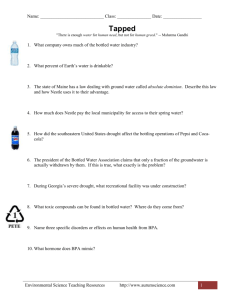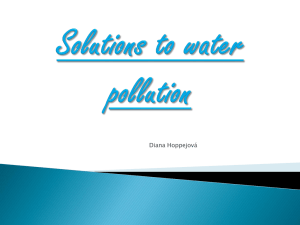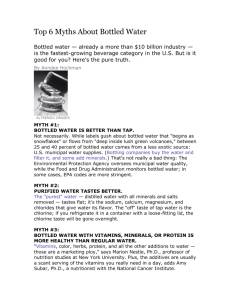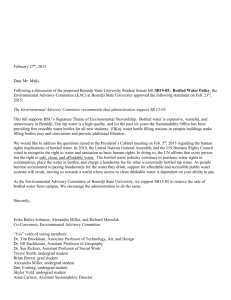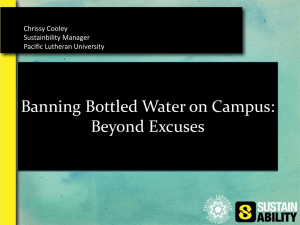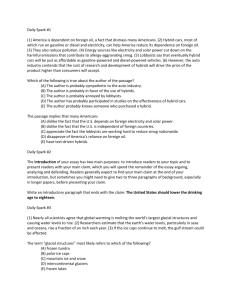What`s in Your Bottled Water?
advertisement
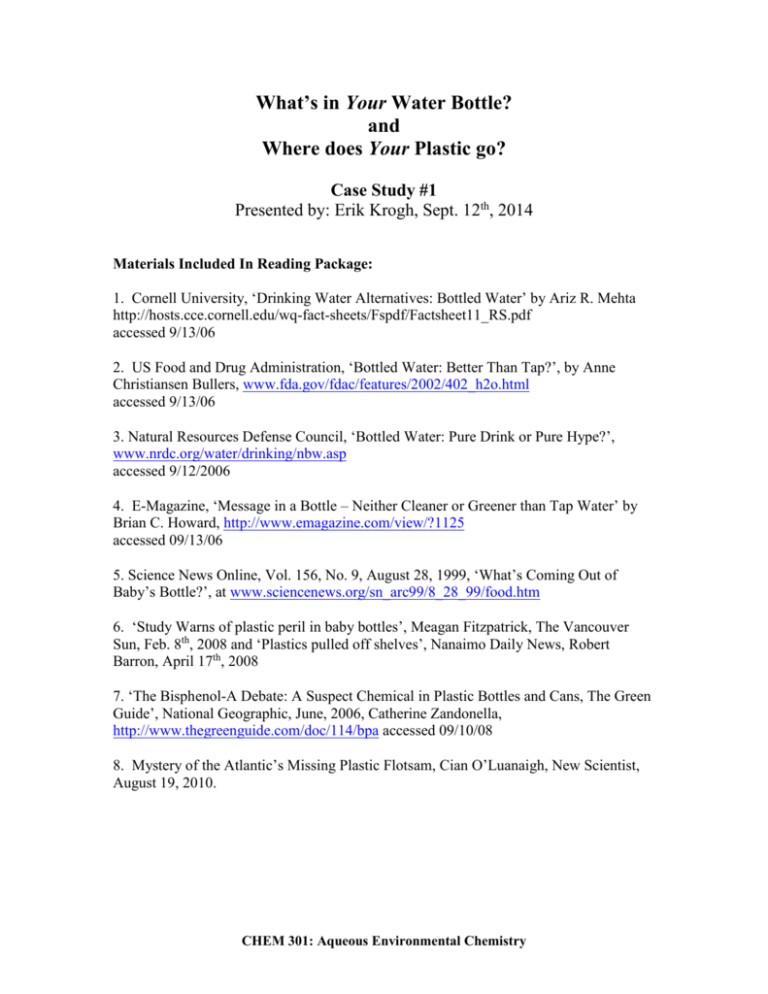
What’s in Your Water Bottle? and Where does Your Plastic go? Case Study #1 Presented by: Erik Krogh, Sept. 12th, 2014 Materials Included In Reading Package: 1. Cornell University, ‘Drinking Water Alternatives: Bottled Water’ by Ariz R. Mehta http://hosts.cce.cornell.edu/wq-fact-sheets/Fspdf/Factsheet11_RS.pdf accessed 9/13/06 2. US Food and Drug Administration, ‘Bottled Water: Better Than Tap?’, by Anne Christiansen Bullers, www.fda.gov/fdac/features/2002/402_h2o.html accessed 9/13/06 3. Natural Resources Defense Council, ‘Bottled Water: Pure Drink or Pure Hype?’, www.nrdc.org/water/drinking/nbw.asp accessed 9/12/2006 4. E-Magazine, ‘Message in a Bottle – Neither Cleaner or Greener than Tap Water’ by Brian C. Howard, http://www.emagazine.com/view/?1125 accessed 09/13/06 5. Science News Online, Vol. 156, No. 9, August 28, 1999, ‘What’s Coming Out of Baby’s Bottle?’, at www.sciencenews.org/sn_arc99/8_28_99/food.htm 6. ‘Study Warns of plastic peril in baby bottles’, Meagan Fitzpatrick, The Vancouver Sun, Feb. 8th, 2008 and ‘Plastics pulled off shelves’, Nanaimo Daily News, Robert Barron, April 17th, 2008 7. ‘The Bisphenol-A Debate: A Suspect Chemical in Plastic Bottles and Cans, The Green Guide’, National Geographic, June, 2006, Catherine Zandonella, http://www.thegreenguide.com/doc/114/bpa accessed 09/10/08 8. Mystery of the Atlantic’s Missing Plastic Flotsam, Cian O’Luanaigh, New Scientist, August 19, 2010. CHEM 301: Aqueous Environmental Chemistry Further Resources: Drinkable Water Book, WaterisLife.com Health Canada, ‘Drinking Water’ http://www.hc-sc.gc.ca/ewh-semt/water-eau/drink-potab/index_e.html Tapped Out: The True Cost of Bottled Water, The Green Guide, National Geographic, August 2007, Solvie Karlstrom, http://www.thegreenguide.com/doc/121/bottle ‘Bottled Water Blues’, at www.bottledwaterblues.com/Bottled_Water_Facts.cfm World Health Organization, Fact Sheet No. 256, October 2000 ‘Bottled Drinking Water’ http://www.who.int/mediacentre/factsheets/fs256/en/ Bottled Waters of the World http://www.finewaters.com/Bottled_Water/Index.asp Scientific American, June, 2003, ‘Bottled Twaddle’, by Michael Shermer http://www.sciam.com/print_version.cfm?articleID=000007F0-6DBD-1ED98E1C809EC588EF21 National Centre for Policy Analysis, ‘Junk Science and Bottled Water’ http://www.ncpa.org./pi/enviro/pd040899c.html The Globe and Mail ‘Bottled water has high level of bacteria, researchers find’, by Carly Weeks, May 25, 2010. Copes, R., Evans, G.M., Verhille, S. Bottled vs Tap, BC Medical Journal, 2009, 112-113. Hampson, N.B., Pollock, N.W., Oxygenated Water and Athletic Performance, J. American Medical Association, 2003, 290, 2408-2409. K.L. Law, S. Moret-Ferguson, N.A. Maximenko, G. Proskurowski, E.E. Peacock, J. Hafner, C.M. Reddy, Plastic Accumulation in the North Atlantic Subtropical Gyre, Science, 329, 1185-1188, 2010. F.I. Colabuono, S.Taniguchi, R.C. Montone, Polychlorinated biphenyls and organochlorine pesticides in plastics ingested by seabirds, Marine Pollution Bulletin, 60, 630-634, 2010. L.M. Rios, C. Moore, P.R. Jones, Persistent organic pollutants carried by synthetic polymers in the ocean environment, Marine Pollution Bulletin, 54, 1230-1237, 2007. CHEM 301: Aqueous Environmental Chemistry Table 1. Bottled Water Definitions and Labels Drinking water Bottled water that is obtained from an approved source, meets all applicable federal and state standards, and has undergone a minimal treatment process consisting of filtration and some type of disinfection Mineral water Water that is collected and bottled directly at the point of emergence from a protected underground source without any treatment to alter its natural mineral composition (i.e., minerals cannot be added to this product). Mineral water contains at least 250 milligrams per liter (mg/L) of natural dissolved substances and is distinguished from other types of bottled water by its constant level and relative proportions of natural minerals and trace elements in the source water. Well water Water that is pumped or collected using some other mechanical means from a bored or drilled well that taps into a groundwater aquifer (a water-bearing rock or soil formation located underground) Artesian water Water that is collected from a bored or drilled well that taps into an aquifer trapped beneath a confining layer of impermeable clay or bedrock, which pressurizes the groundwater and allows it to rise up through the well to an elevation above the water table without mechanical pumping Spring water Water that is collected directly from an underground formation from which water flows naturally to the ground surface or from a bored hole that taps the source of the spring. Although spring water requires minimal treatment before it is bottled, it must retain the same physical properties and composition as the natural spring water. Purified water Water that has been produced by a suitable treatment process such as distillation, deionization, or reverse osmosis and meets the most recent definition of purified water in the United States Pharmacopeia Distilled water Water that has been produced by vaporizing and then condensing the water during the process of distillation. Distilled water must also meet the definition of purified water in the United States Pharmacopeia. Water that contains natural or added carbon dioxide in the same amount that it had at the point of emergence from its source. Sparkling water does not include soft drinks, such as carbonated, soda, seltzer, and tonic waters, which are regulated differently and may contain sugar and calories. Taken from: ‘Drinking Water Alternatives: Bottled Water’ by Ariz R. Mehta at www.cce.cornell.edu/factsheets/wq-fact-sheets/bottled_water.htm Sparkling water CHEM 301: Aqueous Environmental Chemistry Figure 1. Water Treatment Processes. This material is based upon work supported by the U.S. Department of Agriculture, Extension Service, under project number 89-EWQI-1-9168. CHEM 301: Aqueous Environmental Chemistry TABLE 2 Selected Contaminants of Potential Concern for Bottled Water Contaminant Health Concern with Excess Levels Coliform Bacteria Broad class of bacteria used as potential indicator of fecal contamination; may be harmless of themselves. Harmful types of coliform bacteria (such as certain fecal coliform bacteria or E. coli) can cause infections with vomiting, diarrhea, or serious illness in children, the elderly, and immunocompromised or other vulnerable people. Heterotrophic Plate Count (HPC) Bacteria Potential indicator of overall sanitation in bottling and source water; may be harmless of themselves. In some cases may indicate presence of infectious bacteria; data show sometimes linked to illnesses. Can interfere with detection of coliform bacteria or infectious bacteria. Unregulated by FDA. Pseudomonas aeruginosa bacteria Possible indicator of fecal contamination or unsanitary source water or bottling. Can cause opportunistic infections. Unregulated by FDA. Arsenic Known human carcinogen. Also can cause skin, nervous, and reproductive or developmental problems. Nitrate Causes "blue baby" syndrome in infants, due to interference with blood's ability to take up oxygen. Potential cancer risk. Trihalomethanes (i.e., chloroform, bromodichloromethane, dibromochloromethane, and bromoform) Cancer of the bladder, colorectal cancer, possibly pancreatic cancer. Also concerns about possible birth defects and spontaneous abortions. Phthalate (DEHP) Cancer; possible endocrine system disrupter. Unregulated by FDA. Source: NRDC CHEM 301: Aqueous Environmental Chemistry Note re Crystal Geyser: The Crystal Geyser company has provided NRDC with test results indicating that beginning in April 1999, Crystal Geyser substantially reduced the arsenic levels in its spring water, in an agreement reached after they were sued (based on NRDC's previous test results) by the Environmental Law Foundation, a California Public Interest Group. This testing shows that as of April 1999, arsenic is either not found, or, if present, is found at levels between non-detectable (<2 ppb) and 4.8 ppb, maximum. These levels are below the California Proposition 65 arsenic warning level of 5 ppb and well below current federal standard, but EPA recently has proposed to drop the federal drinking water standard to 5 ppb. FIGURE 5: Arsenic in Selected Bottled Waters (Source: NRDC, 1997-1999) FIGURE 6: Significant Total Trihalomethane Levels in Bottled Water (Source: NRDC, 1997-1999) CHEM 301: Aqueous Environmental Chemistry Message in a Bottle: Despite the Hype, Bottled Water is Neither CLEANER nor GREENER Than Tap Water Whether a consumer is shopping in a supermarket or a health food store, working out in a fitness center, eating in a restaurant or grabbing some quick refreshment on the go, he or she will likely be tempted to buy bottled water. The product comes in an ever-growing variety of sizes and shapes, including one bottle that looks like a drop of water with a golden cap. Some fine hotels now offer the services of “water sommeliers” to advise diners on which water to drink with different courses. A widening spectrum of bottled water types are crowding the market, including spring, mineral, purified, distilled, carbonated, oxygenated, caffeinated and vitamin-enriched, as well as flavors, such as lemon or strawberry, and specific brands aimed at children. Bottled water bars have sprung up in the hipper districts, from Paris to Los Angeles. The message is clear: Bottled water is “good” water, as opposed to that nasty, unsafe stuff that comes out of the tap. But in most cases tap water adheres to stricter purity standards than bottled water, whose source—far from a mountain spring—can be wells underneath industrial facilities. Indeed, 40 percent of bottled water began life as, well, tap water. A 2001 World Wildlife Fund (WWF) study confirmed the widespread belief that consumers associate bottled water with social status and healthy living. Their perceptions trump their objectivity, because even some people who claim to have switched to bottled water “for the taste” can’t tell the difference: When Good Morning America conducted a taste test of its studio audience, New York City tap water was chosen as the heavy favorite over the oxygenated water 02, Poland Spring and Evian. Many of the “facts” that bottled water drinkers swear by are erroneous. Rachele Kuzma, a Rutgers student, says she drinks bottled water at school because “it’s healthier” and “doesn’t have fluoride,” although much of it does have fluoride. Bottled water is so ubiquitous that people can hardly ask for water anywhere without being handed a bottle. But what is the cost to society and the environment? Largely Self-Regulated The bottled water industry has exploded in recent years, and enjoys annual sales of more than $35 billion worldwide. In 2002, almost six billion gallons of bottled water were sold in the U.S., representing an increase of nearly 11 percent over 2001. Americans paid $7.7 billion for bottled water in 2002, according to the consulting and research firm Beverage Marketing Corporation. Bottled water is the fastest-growing segment of the beverage industry, and the product is expected to pass both coffee and milk to become the second-most-consumed beverage (behind soft drinks) by 2004. According to the Natural Resources Defense Council (NRDC), “More than half of all Americans drink bottled water; about a third of the public consumes it regularly.” While most people would argue that bottled water is healthier than convenient alternatives like sugared sodas or artificially flavored drinks, are the third of bottled water consumers who claim they are motivated by promises of purity (according to a 2000 survey) getting what they pay for? While the Environmental Protection Agency (EPA) regulates the quality of public water supplies, the agency has no authority over bottled water. Bottled water that crosses state lines is considered a food product and is overseen by the Food and Drug Administration (FDA), which does mandate that it be bottled in sanitary conditions using food-grade equipment. According to the influential International Bottled Water Association (IBWA), “By law, the FDA Standard of Quality for bottled water must be as stringent as the EPA’s standards for public drinking water.” A 1997 United Nations report concluded that bottled water has no nutritional advantage over tap water, so why do so many people think otherwise? CHEM 301: Aqueous Environmental Chemistry What’s Really in that Bottle? Even with widespread disinfection, consumer groups have raised numerous warnings about a host of different microorganisms and chemicals that have been found in bottled water. In a four-year scientific study, the NRDC tested more than 1,000 bottles of 103 brands of bottled water. The group concluded, “Although most bottled water tested was of good quality, some brands’ quality was spotty.” A third of the tested brands were found to contain contaminants such as arsenic and carcinogenic compounds in at least some samples at levels exceeding state or industry standards. An earlier NRDC-commissioned study tested for hundreds of different chemicals in 38 brands of California bottled water. Two samples had arsenic contamination, six had chemical byproducts of chlorination, and six had measurable levels of the toxic chemical toluene. Several samples violated California’s bottled water standards. In a study published in the Archives of Family Medicine, researchers at Case Western Reserve University and Ohio State University compared 57 samples of bottled water to Cleveland’s tap water. While 39 of the bottled water samples were purer than the tap water, 15 of the bottles had significantly higher bacteria levels. The scientists concluded that although all of the water they tested was safe to drink, “use of bottled water on the assumption of purity can be misguided.” Another area of potential concern is the fact that no agency calls for testing of bottled water after it leaves its initial packaging plant, leaving some to wonder what happens during months of storage and transport. To begin to examine this question, the Kansas Department of Health and Environment tested 80 samples of bottled water from retail stores and manufacturers. All 80 of the samples had detectable levels of chlorine, fluoride and sodium. Seventy-eight of the 80 contained some nitrate (which can cause methemoglobinemia, or blue-baby syndrome, in higher doses), 12 had nitrite, 53 had chloroform, 33 contained bromodichloro-methane, 25 had arsenic and 15 tested positive for lead. Forty-six of the samples contained traces of some form of the carcinogen (and hormone disrupter) phthalate, while 12 of those exceeded federal safety levels for that chemical. According to Olson, phthalates may leach out of some plastic bottles into water. “Phthalates are not legally regulated in bottled water because of intense industry pressure,” says Olson. Although Co-op America concludes that there is little evidence of a link between phthalate exposure from bottled water and any health problems, the group suggests using glass over plastic bottles as a precaution. Similarly, if your office cooler is made of polycarbonate, it may be releasing small amounts of the potential hormone disrupter bisphenol A into the water. Plastic water bottles can take 1,000 years to biodegrade. Nine out of 10 water bottles end up as garbage or litter, and that means 30 million per day. A small percentage goes into recycling bins like the one below. CHEM 301: Aqueous Environmental Chemistry Misleading Labels Another complaint commonly levied against the bottled water industry is that many of the myriad product labels are misleading. Not long ago, New York-based artist Nancy Drew began collecting water bottles for a project. She concluded, “In a culture so inundated with images solely designed for promotion and profit, water is the most absurd element to see being used in this context.” Drew’s subsequent art views water labels’ ubiquitous depictions of pristine landscapes as a stark contrast to the “gluttonous consumption and sense of status that they represent.” The IBWA states, “The labeling requirements ensure that the source and purity of the bottled water are identified and that, if the label is false or misleading, the supplier is subject to civil or criminal sanctions.” Even so, the FDA technically requires that bottled water labels disclose only three variables: the class of water (such as spring or mineral), the manufacturer, and the volume. That brand of Massachusetts “spring water” exposed by NRDC was so-named because the source occasionally bubbled up to the surface in the industrial parking lot. As ABC News put it, “Ad campaigns touting spring-fed or glacier-born H2O are winning over a population increasingly skeptical of taps and willing to shell out big bucks for what they consider a purer, tastier and safer drink.” Water bottlers use product names such as More Precious Than Gold, Ice Mountain, Desert Quench, Pure American, Utopia and Crystal Springs. The Environmental Law Foundation has sued eight bottlers on the basis that they used words like “pure” to market water containing bacteria, arsenic and chlorine breakdown products. Co-op America advises consumers “to be wary of words like ‘pure,’ ‘pristine,’ ‘glacial,’ ‘premium,’ ‘natural’ or ‘healthy.’ They’re basically meaningless words added to labels to emphasize the alleged purity of bottled water over tap water.” The group points out that, in one case, bottled water labeled as “Alaska Premium Glacier Drinking Water: Pure Glacier Water from the Last Unpolluted Frontier” was actually drawn from Public Water System #111241 in Juneau. The FDA now requires this bottler to add “from a municipal source” on the label. According to Co-op America, “as much as 40 percent of bottled water is actually bottled tap water, sometimes with additional treatment, sometimes not.” So-called purified water can be drawn from any source as long as it is subsequently treated, which leaves some to wonder how that differs from good old tap water. The number one (Aquafina) and two (Dasani) top-selling brands of bottled water in the U.S. both fall in the category of purified water. Dasani is sold by Coca-Cola, while Aquafina is a Pepsi product. As U.S. News & World Report explains, “Aquafina is municipal water from spots like Wichita, Kansas.” The newsmagazine continues, “Coke’s Dasani (with minerals added) is taken from the taps of Queens, New York, Jacksonville, Florida, and elsewhere.” Everest bottled water originates from southern Texas, while Yosemite brand is drawn from the Los Angeles suburbs. CHEM 301: Aqueous Environmental Chemistry TTHMs (Total Trihalomethanes) CHX3 X = Cl, Br Cl H Br Cl Br Cl H Cl Cl chloroform BDCM Phthalate O O O O Bisphenol-A HO OH CHEM 301: Aqueous Environmental Chemistry H Br Cl DBCM What’s Coming Out of Baby’s Bottle? Biles, J.E., et al. 1997. Determination of bisphenol-A in reusable polycarbonate food-contact plastics and migration to food-simulating liquids. J. of Agric. Food Chem. 45, 3541. CHEM 301: Aqueous Environmental Chemistry Mystery of the Atlantic's missing plastic flotsam Cian O’Luanaigh, New Scientist, 19 August 2010 http://www.newscientist.com/data/images/ns/cms/dn19340/dn19340-2_3 The amount of floating plastic trapped in a north Atlantic current system hasn't got any bigger in 22 years, despite more and more plastic being thrown away. Since 1986 students taking samples of plankton in the Atlantic and Caribbean Oceans have also noted when their nets caught plastic debris. Kara Lavender and colleagues at the Sea Education Association in Woods Hole, Massachusetts, analysed the data, and found that of 6136 samples recorded, more than 60 per cent included pieces of plastic, typically just millimetres across. The areas of highest plastic concentration are within the north Atlantic subtropical gyre, where currents gather the debris. Lavender and her team were surprised to find that the amount of floating plastic had not increased in the gyre. Although it has been illegal since the 1970s for ships to throw plastic overboard, Lavender thinks that the overall rate of plastic rubbish reaching the ocean will have increased, given the fivefold increase in global production of plastic since 1976. Slipping through the net? "Where the extra plastic is going is the big mystery," she says. Plastic resists biodegradation and can last decades or more in the ocean. Eventually sunlight and wave motion break it into smaller pieces, which can be harmful to marine life – CHEM 301: Aqueous Environmental Chemistry clogging the stomachs of fish and seabirds, for example. Law suggests that the plastic might be degrading into pieces small enough to pass through the 0.3-millimetre-mesh nets used in the study, or becoming coated in biofilms and sinking out of range of the nets. However it is unclear why the rate of degradation during the study period should have increased to offset the extra plastic going into the ocean. She says it is unlikely that ocean currents are pushing plastic out of the gyre, although Simon Boxall of the National Oceanography Centre in Southampton, UK, who wasn't involved in the study, disagrees. He says the Atlantic gyre has an exit strategy in the form of the Gulf Stream. "We've seen high levels of plastic in the Arctic" he says. Eternal pollution Wherever it is going at the moment, the plastic on our oceans will eventually be broken down into microscopic pieces and individual molecules whose environmental effect is unknown. "The million-dollar question is, is it causing any damage?" says Boxall. "When plastic particles get so small are they just like roughage going through the system? Some studies suggest that persistent chemicals in newer plastics function as endocrine disruptors and mimic hormones such as oestrogen." And this fine-grained plastic is very long-lived. "The depressing thing is it's likely to remain in the oceans essentially forever," says Lavender. CHEM 301: Aqueous Environmental Chemistry
